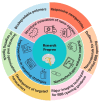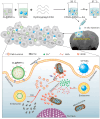Recent progress on nanotechnologies for enhancing blood-brain barrier permeability
- PMID: 40671921
- PMCID: PMC12262015
- DOI: 10.1002/smo.20240052
Recent progress on nanotechnologies for enhancing blood-brain barrier permeability
Abstract
The blood-brain barrier (BBB) is a substantial impediment to effectively delivering central nervous system (CNS) therapies. In this review, we provide a comprehensive dissection of the BBB's elaborate structure and function and discuss the inherent limitations of conventional drug delivery mechanisms due to its impermeability. We summarized the creative deployment of nanocarriers, the astute modification of small molecules to bolster their CNS penetration capabilities as well as the burgeoning potential of magnetic nanoparticles and optical techniques that are positioned to enable more precise and targeted drug delivery across the BBB and we discuss the current clinical application of some nanomedicines. In addition, we emphasize the indispensable role of artificial intelligence in designing novel materials and the paramount significance of interdisciplinary research in surmounting clinical challenges associated with BBB penetration. Our review meticulously integrates these insights to accentuate the impact of nanotechnological innovations in BBB research and CNS disease management. It presents a promising trajectory for the evolution of patient care in neurological disorders and suggests that these scientific strides could lead to more efficacious treatments and improved outcomes for those afflicted with such conditions.
Keywords: biological activity; imaging agents; nanoparticles; nanotechnology; polymers.
© 2025 The Author(s). Smart Molecules published by John Wiley & Sons Australia, Ltd on behalf of Dalian University of Technology.
Conflict of interest statement
Prof. Guiseppi‐Elie is the founder, president, and scientific director of ABTECH Scientific, Inc., a manufacturer of microfabricated electrodes, devices and systems used in biomedical diagnostics and the measurement of physiological data.
Figures









Similar articles
-
Management of urinary stones by experts in stone disease (ESD 2025).Arch Ital Urol Androl. 2025 Jun 30;97(2):14085. doi: 10.4081/aiua.2025.14085. Epub 2025 Jun 30. Arch Ital Urol Androl. 2025. PMID: 40583613 Review.
-
Conservative, physical and surgical interventions for managing faecal incontinence and constipation in adults with central neurological diseases.Cochrane Database Syst Rev. 2024 Oct 29;10(10):CD002115. doi: 10.1002/14651858.CD002115.pub6. Cochrane Database Syst Rev. 2024. PMID: 39470206
-
Systemic pharmacological treatments for chronic plaque psoriasis: a network meta-analysis.Cochrane Database Syst Rev. 2021 Apr 19;4(4):CD011535. doi: 10.1002/14651858.CD011535.pub4. Cochrane Database Syst Rev. 2021. Update in: Cochrane Database Syst Rev. 2022 May 23;5:CD011535. doi: 10.1002/14651858.CD011535.pub5. PMID: 33871055 Free PMC article. Updated.
-
Uncommon Non-MS Demyelinating Disorders of the Central Nervous System.Curr Neurol Neurosci Rep. 2025 Jul 1;25(1):45. doi: 10.1007/s11910-025-01432-8. Curr Neurol Neurosci Rep. 2025. PMID: 40591029 Review.
-
Antidepressants for pain management in adults with chronic pain: a network meta-analysis.Health Technol Assess. 2024 Oct;28(62):1-155. doi: 10.3310/MKRT2948. Health Technol Assess. 2024. PMID: 39367772 Free PMC article.
References
Publication types
LinkOut - more resources
Full Text Sources
